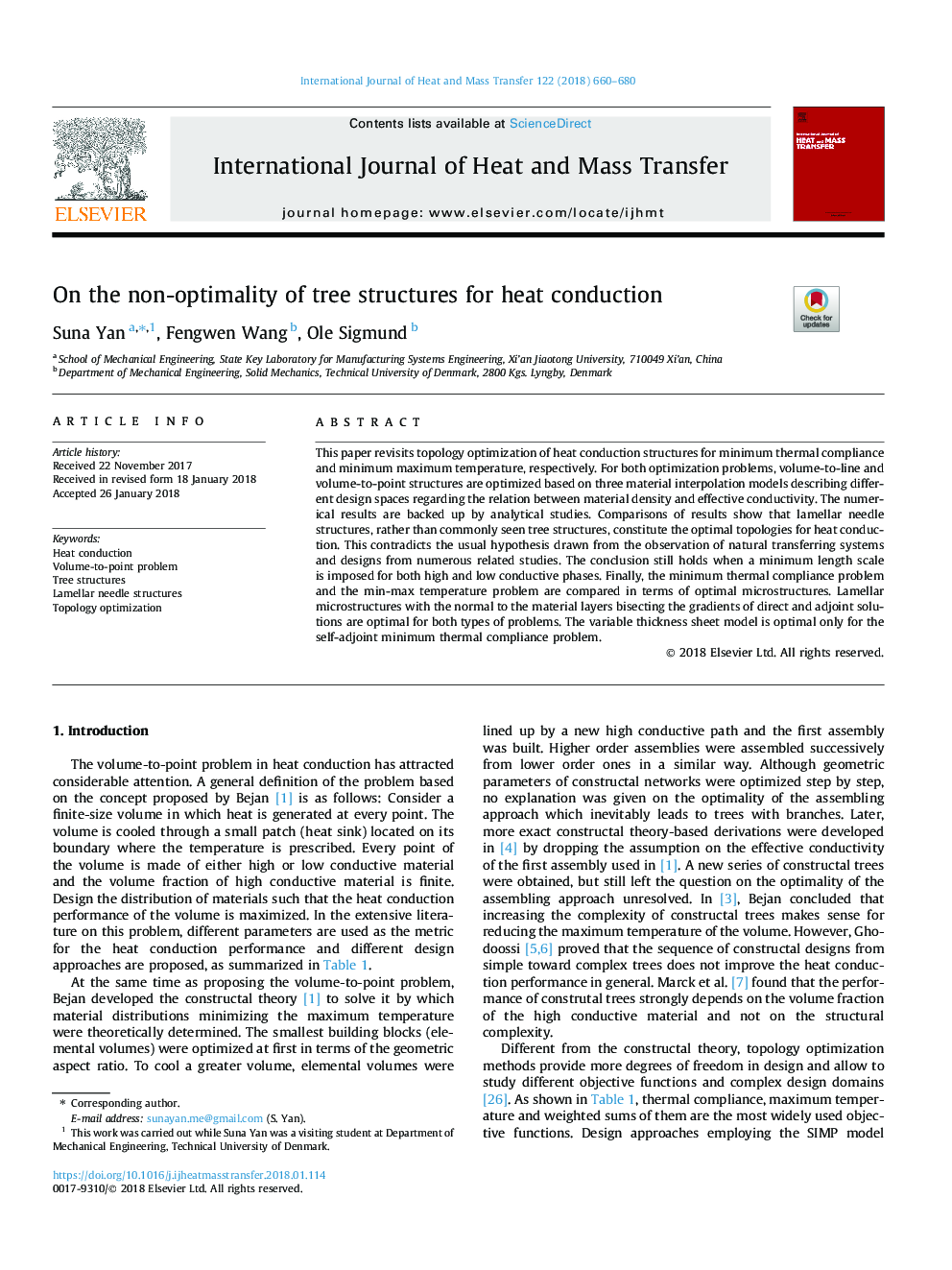| کد مقاله | کد نشریه | سال انتشار | مقاله انگلیسی | نسخه تمام متن |
|---|---|---|---|---|
| 7054401 | 1458018 | 2018 | 21 صفحه PDF | دانلود رایگان |
عنوان انگلیسی مقاله ISI
On the non-optimality of tree structures for heat conduction
ترجمه فارسی عنوان
در غیر بهینه سازی ساختار درخت برای هدایت گرما
دانلود مقاله + سفارش ترجمه
دانلود مقاله ISI انگلیسی
رایگان برای ایرانیان
کلمات کلیدی
انتقال حرارت، مشکل حجم به نقطه، سازه های درختی، ساختار سوزن لامالر، بهینه سازی توپولوژی،
ترجمه چکیده
این مقاله به منظور بهینه سازی توپولوژی ساختارهای هدایت حرارتی برای حداقل تطابق حرارتی و حداقل حداکثر درجه حرارت مجددا بررسی می شود. برای هر دو مشکل بهینه سازی، ساختارهای حجم به خط و حجم به نقطه بر اساس سه مدل درونیابی مواد توصیف فضاهای طراحی های مختلف در رابطه با چگالی ماده و هدایت موثر بهینه سازی شده است. نتایج عددی توسط مطالعات تحلیلی حمایت می شوند. مقایسه نتایج نشان می دهد که ساختارهای سوزن لاملار، به جای ساختارهای درختی که معمولا دیده می شوند، توپولوژی مطلوب برای هدایت گرما را تشکیل می دهند. این بر خلاف فرضیه معمولی است که از مشاهدات سیستم های انتقال طبیعی و طرح های مختلف از مطالعات مرتبط با آن پیروی می کند. این نتیجه گیری هنوز ادامه دارد وقتی مقیاس حداقل طول برای فازهای بالا و پایین هدایت می شود. در نهایت، حداقل ملاحظات رعایت حرارتی و مشکل دمای مینیمکس با توجه به میکروساختارهای مطلوب مقایسه می شود. ریزپردازنده های لایه ای با لایه های معمولی به لایه های مواد، تقسیم شیب های راه حل مستقیم و متصل، بهینه برای هر دو نوع مشکالت است. مدل ورق ضخامت متغیر تنها برای کمینه ی تضمین حداقل حرارتی خودکارشناسی مطلوب است.
موضوعات مرتبط
مهندسی و علوم پایه
مهندسی شیمی
جریان سیال و فرایندهای انتقال
چکیده انگلیسی
This paper revisits topology optimization of heat conduction structures for minimum thermal compliance and minimum maximum temperature, respectively. For both optimization problems, volume-to-line and volume-to-point structures are optimized based on three material interpolation models describing different design spaces regarding the relation between material density and effective conductivity. The numerical results are backed up by analytical studies. Comparisons of results show that lamellar needle structures, rather than commonly seen tree structures, constitute the optimal topologies for heat conduction. This contradicts the usual hypothesis drawn from the observation of natural transferring systems and designs from numerous related studies. The conclusion still holds when a minimum length scale is imposed for both high and low conductive phases. Finally, the minimum thermal compliance problem and the min-max temperature problem are compared in terms of optimal microstructures. Lamellar microstructures with the normal to the material layers bisecting the gradients of direct and adjoint solutions are optimal for both types of problems. The variable thickness sheet model is optimal only for the self-adjoint minimum thermal compliance problem.
ناشر
Database: Elsevier - ScienceDirect (ساینس دایرکت)
Journal: International Journal of Heat and Mass Transfer - Volume 122, July 2018, Pages 660-680
Journal: International Journal of Heat and Mass Transfer - Volume 122, July 2018, Pages 660-680
نویسندگان
Suna Yan, Fengwen Wang, Ole Sigmund,
